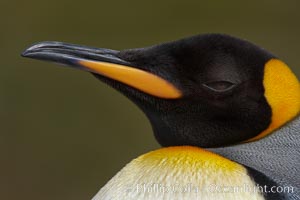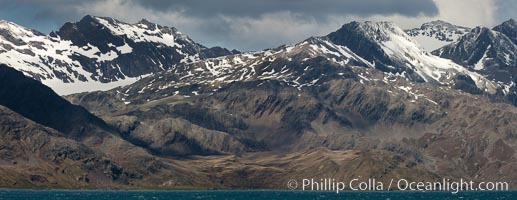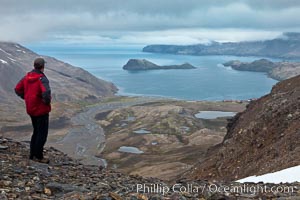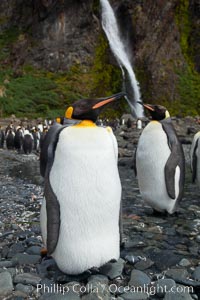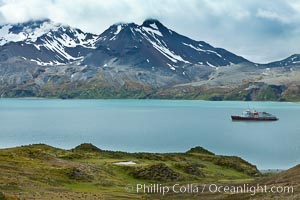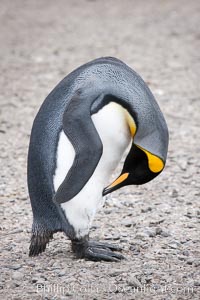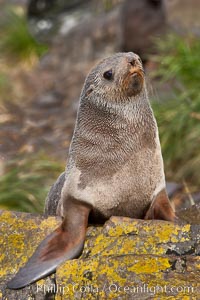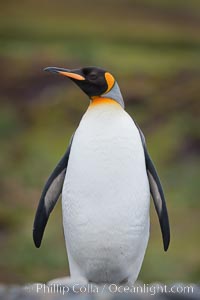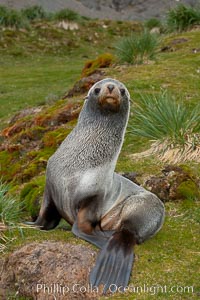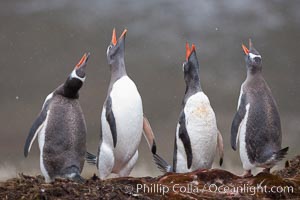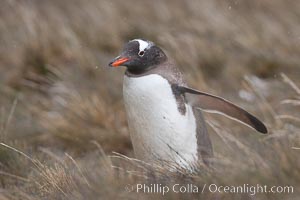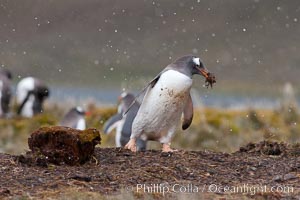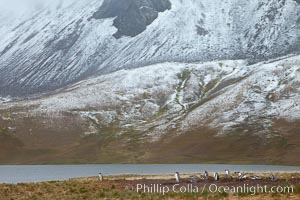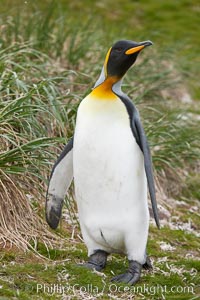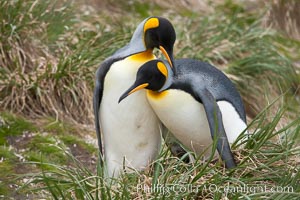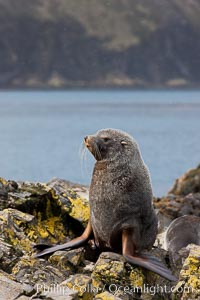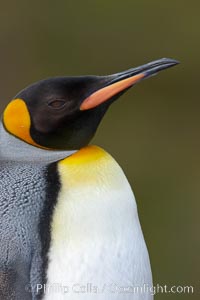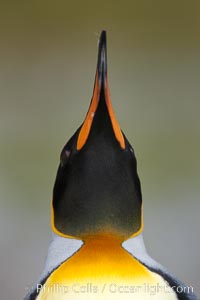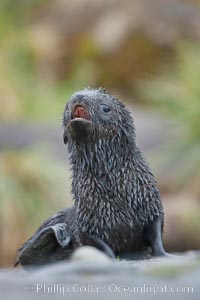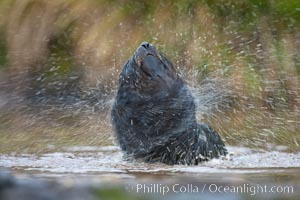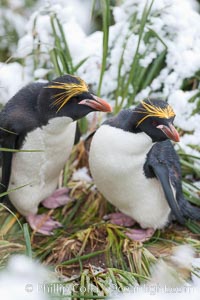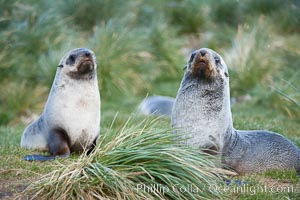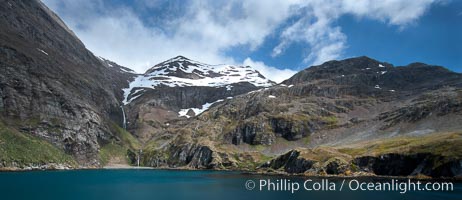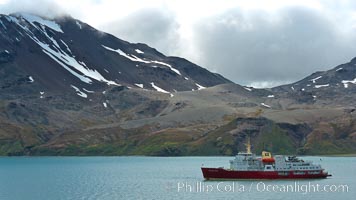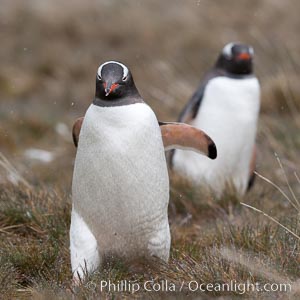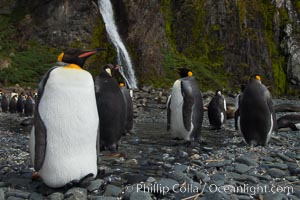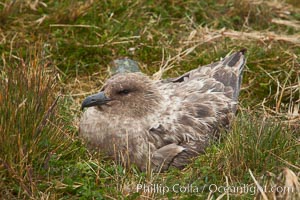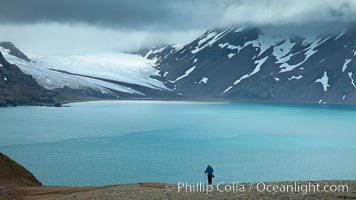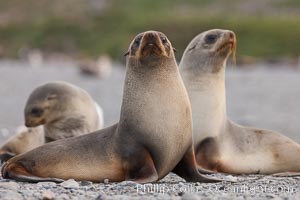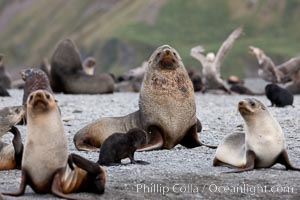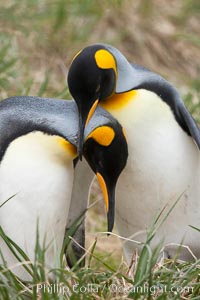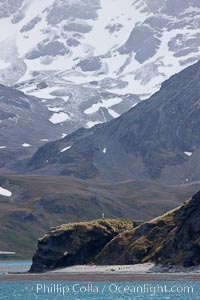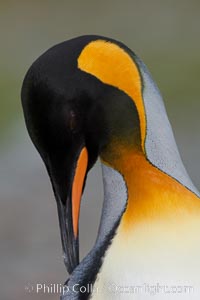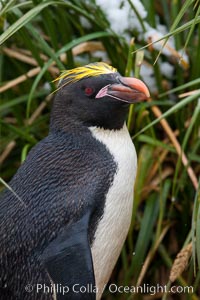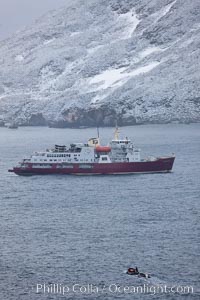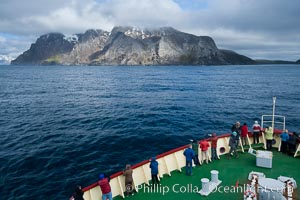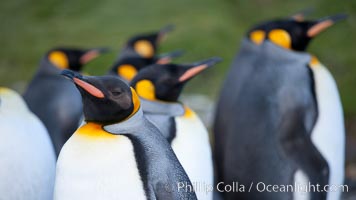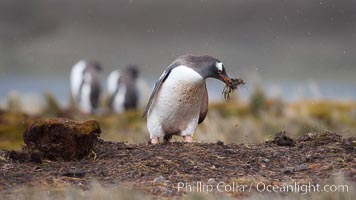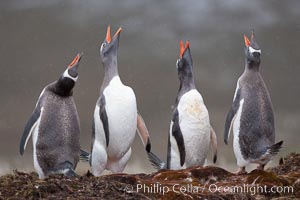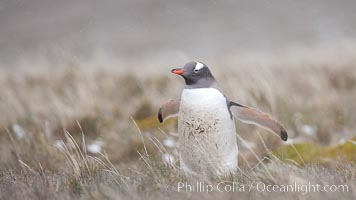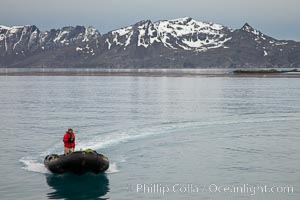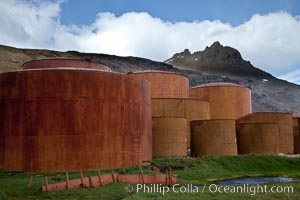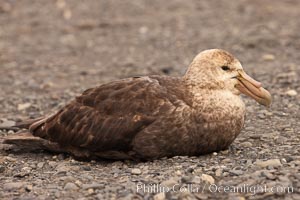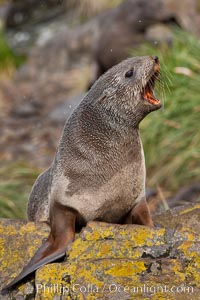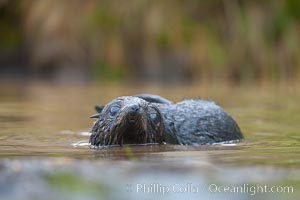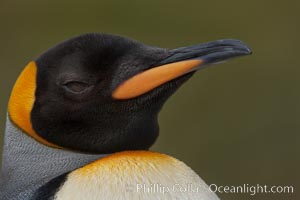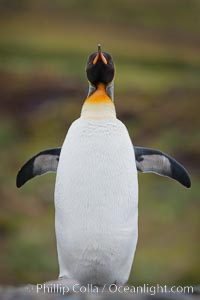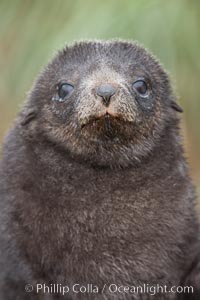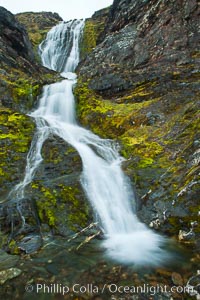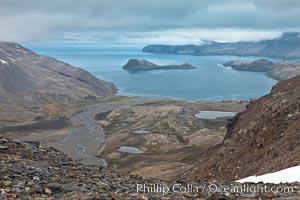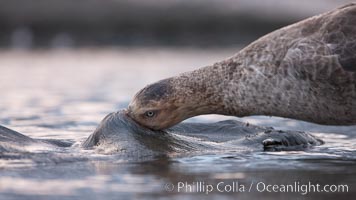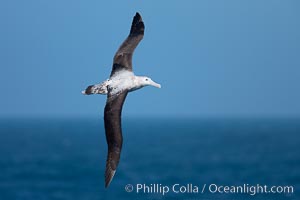
Wandering albatross in flight, over the open sea. The wandering albatross has the largest wingspan of any living bird, with the wingspan between, up to 12' from wingtip to wingtip. It can soar on the open ocean for hours at a time, riding the updrafts from individual swells, with a glide ratio of 22 units of distance for every unit of drop. The wandering albatross can live up to 23 years. They hunt at night on the open ocean for cephalopods, small fish, and crustaceans. The survival of the species is at risk due to mortality from long-line fishing gear.
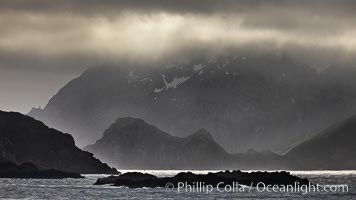
South Georgia Island coastline, showing the island's characteristic rugged topography. 56% of the island is covered by 161 glaciers, which have created numerous large bays and inlets that provide excellent habitat for marine animals and seabirds. Mountains meet the sea in steep-sided seacliffs covered with sparse vegetation. The highest point on South Georgia Island is Mt. Paget at 2,915m.
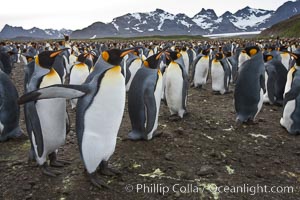
King penguin colony. Over 100,000 pairs of king penguins nest at Salisbury Plain, laying eggs in December and February, then alternating roles between foraging for food and caring for the egg or chick.
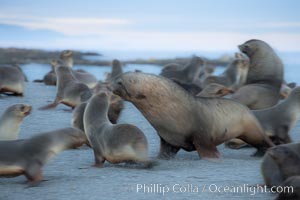
Adult male Antarctic fur seal (bull), chasing down a female in his harem to confirm his dominance, during mating season.
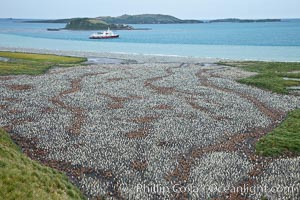
King penguin colony and the Bay of Isles on the northern coast of South Georgia Island. Over 100,000 nesting pairs of king penguins reside here. Dark patches in the colony are groups of juveniles with fluffy brown plumage. The icebreaker M/V Polar Star lies at anchor.
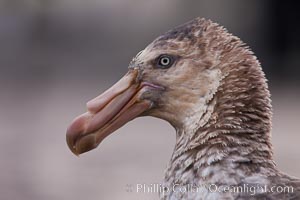
Northern giant portrait, profile, head detail. The distinctive tube nose (naricorn), characteristic of species in the Procellariidae family (tube-snouts), is easily seen.
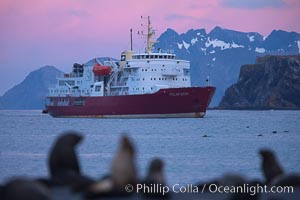
M/V Polar Star, an icebreaker expedition ship, lies at anchor in Right Whale Bay, South Georgia Island. Antarctic fur seals on the beach, and the rugged South Georgia Island mountains in the distance. Sunset, dusk.
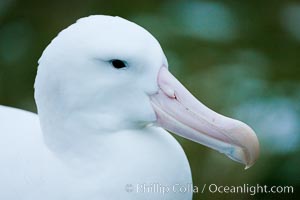
Wandering albatross, on nest and the Prion Island colony. The wandering albatross has the largest wingspan of any living bird, with the wingspan between, up to 12' from wingtip to wingtip. It can soar on the open ocean for hours at a time, riding the updrafts from individual swells, with a glide ratio of 22 units of distance for every unit of drop. The wandering albatross can live up to 23 years. They hunt at night on the open ocean for cephalopods, small fish, and crustaceans. The survival of the species is at risk due to mortality from long-line fishing gear.
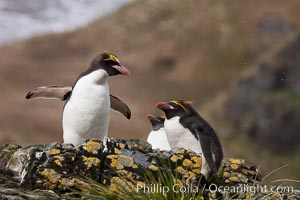
Macaroni penguins, on the rocky shoreline of Hercules Bay, South Georgia Island. One of the crested penguin species, the macaroni penguin bears a distinctive yellow crest on its head. They grow to be about 12 lb and 28" high. Macaroni penguins eat primarily krill and other crustaceans, small fishes and cephalopods.
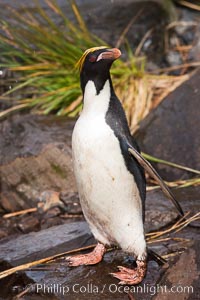
Macaroni penguin, on the rocky shoreline of Hercules Bay, South Georgia Island. One of the crested penguin species, the macaroni penguin bears a distinctive yellow crest on its head. They grow to be about 12 lb and 28" high. Macaroni penguins eat primarily krill and other crustaceans, small fishes and cephalopods.
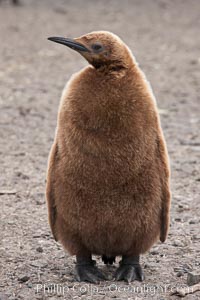
Oakum boys, juvenile king penguins at Salisbury Plain, South Georgia Island. Named 'oakum boys' by sailors for the resemblance of their brown fluffy plumage to the color of oakum used to caulk timbers on sailing ships, these year-old penguins will soon shed their fluffy brown plumage and adopt the colors of an adult.
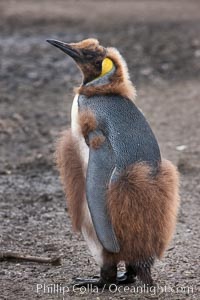
Oakum boys, juvenile king penguins at Salisbury Plain, South Georgia Island. Named 'oakum boys' by sailors for the resemblance of their brown fluffy plumage to the color of oakum used to caulk timbers on sailing ships, these year-old penguins will soon shed their fluffy brown plumage and adopt the colors of an adult.
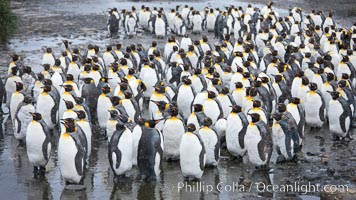
King penguin colony at Salisbury Plain, Bay of Isles, South Georgia Island. Over 100,000 pairs of king penguins nest here, laying eggs in December and February, then alternating roles between foraging for food and caring for the egg or chick.
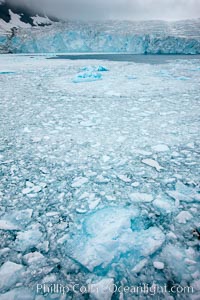
Drygalski Fjord, packed with brash ice which has broken away from Risting Glacier at the end of the narrow fjord.
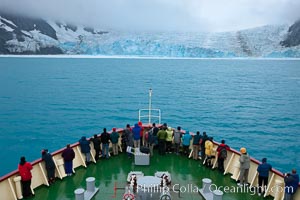
M/V Polar Star approaches Jenkins Glacier (left), Risting Glacier (center) and a third glacier (right) at the end of Drygalski Fjord.
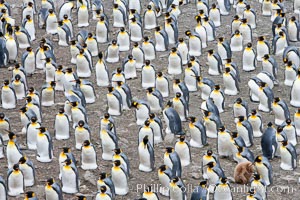
King penguin colony. Over 100,000 pairs of king penguins nest at Salisbury Plain, laying eggs in December and February, then alternating roles between foraging for food and caring for the egg or chick.
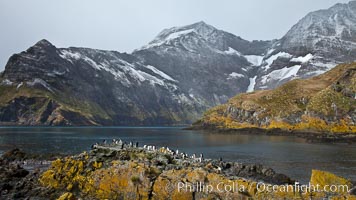
Macaroni penguins, on the rocky shoreline of Hercules Bay, South Georgia Island. One of the crested penguin species, the macaroni penguin bears a distinctive yellow crest on its head. They grow to be about 12 lb and 28" high. Macaroni penguins eat primarily krill and other crustaceans, small fishes and cephalopods.
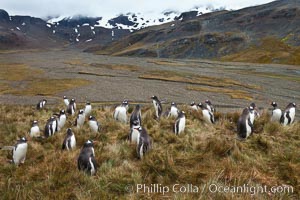
Gentoo penguins, permanent nesting colony in grassy hills about a mile inland from the ocean, near Stromness Bay, South Georgia Island.
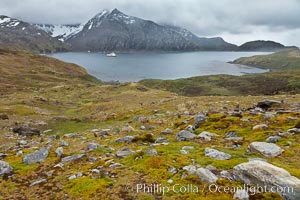
View of Godthul, from the grassy slopes of South Georgia. The name Godthul, or "Good Hollow", dates back to Norwegian whalers who used this bay as a anchorage.
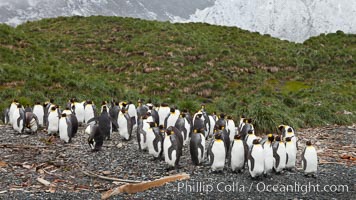
King penguins and whale bones, on the cobblestone beach at Godthul, South Georgia Island. The whale bones are evidence of South Georgia's long and prolific history of whaling.
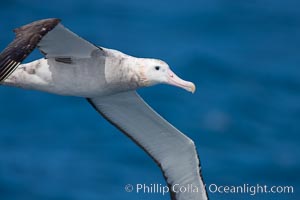
Wandering albatross in flight, over the open sea. The wandering albatross has the largest wingspan of any living bird, with the wingspan between, up to 12' from wingtip to wingtip. It can soar on the open ocean for hours at a time, riding the updrafts from individual swells, with a glide ratio of 22 units of distance for every unit of drop. The wandering albatross can live up to 23 years. They hunt at night on the open ocean for cephalopods, small fish, and crustaceans. The survival of the species is at risk due to mortality from long-line fishing gear.
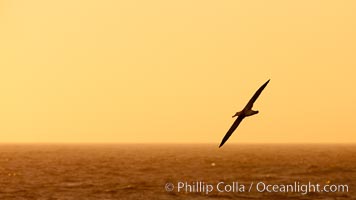
Wandering albatross in flight, over the open sea. The wandering albatross has the largest wingspan of any living bird, with the wingspan between, up to 12' from wingtip to wingtip. It can soar on the open ocean for hours at a time, riding the updrafts from individual swells, with a glide ratio of 22 units of distance for every unit of drop. The wandering albatross can live up to 23 years. They hunt at night on the open ocean for cephalopods, small fish, and crustaceans. The survival of the species is at risk due to mortality from long-line fishing gear.
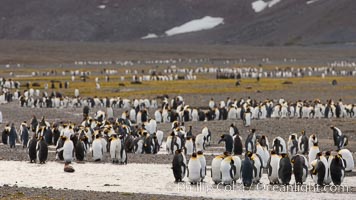
King penguin colony, Right Whale Bay, South Georgia Island. Over 100,000 pairs of king penguins nest on South Georgia Island each summer.
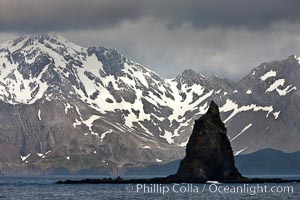
South Georgia Island coastline, showing the island's characteristic rugged topography. 56% of the island is covered by 161 glaciers, which have created numerous large bays and inlets that provide excellent habitat for marine animals and seabirds. Mountains meet the sea in steep-sided seacliffs covered with sparse vegetation. The highest point on South Georgia Island is Mt. Paget at 2,915m.
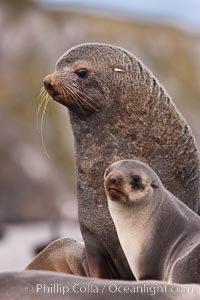
Antarctic fur seals, adult male bull and female, illustrating extreme sexual dimorphism common among pinnipeds (seals, sea lions and fur seals).
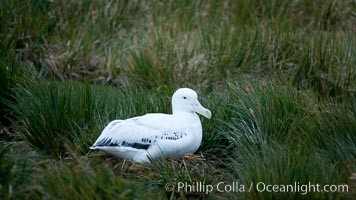
Wandering albatross, on nest in the Prion Island colony. The wandering albatross has the largest wingspan of any living bird, with the wingspan between, up to 12' from wingtip to wingtip. It can soar on the open ocean for hours at a time, riding the updrafts from individual swells, with a glide ratio of 22 units of distance for every unit of drop. The wandering albatross can live up to 23 years. They hunt at night on the open ocean for cephalopods, small fish, and crustaceans. The survival of the species is at risk due to mortality from long-line fishing gear.
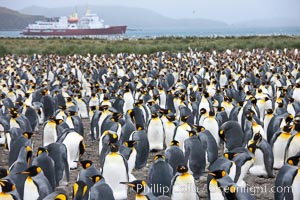
Icebreaker M/V Polar Star anchored in the Bay of Isles,offshore of the vast king penguin colony at Salisbury Plain.
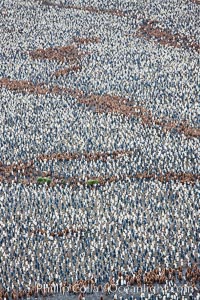
King penguin colony, over 100,000 nesting pairs, viewed from above. The brown patches are groups of 'oakum boys', juveniles in distinctive brown plumage. Salisbury Plain, Bay of Isles, South Georgia Island.
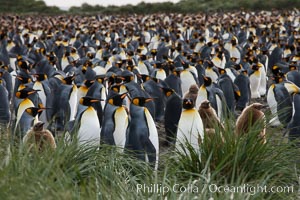
King penguin colony. Over 100,000 pairs of king penguins nest at Salisbury Plain, laying eggs in December and February, then alternating roles between foraging for food and caring for the egg or chick.
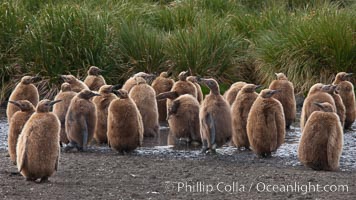
Oakum boys, juvenile king penguins at Salisbury Plain, South Georgia Island. Named 'oakum boys' by sailors for the resemblance of their brown fluffy plumage to the color of oakum used to caulk timbers on sailing ships, these year-old penguins will soon shed their fluffy brown plumage and adopt the colors of an adult.
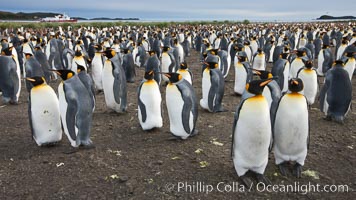
King penguin colony. Over 100,000 pairs of king penguins nest at Salisbury Plain, laying eggs in December and February, then alternating roles between foraging for food and caring for the egg or chick.
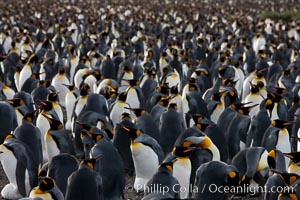
King penguin colony at Salisbury Plain, Bay of Isles, South Georgia Island. Over 100,000 pairs of king penguins nest here, laying eggs in December and February, then alternating roles between foraging for food and caring for the egg or chick.
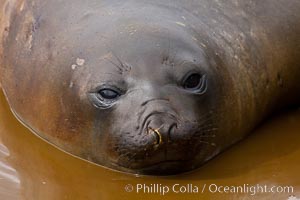
Southern elephant seal, juvenile. The southern elephant seal is the largest pinniped, and the largest member of order Carnivora, ever to have existed. It gets its name from the large proboscis (nose) it has when it has grown to adulthood.
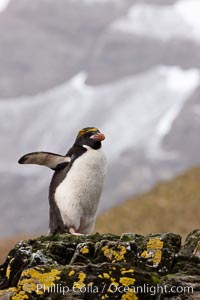
Macaroni penguin, on the rocky shoreline of Hercules Bay, South Georgia Island. One of the crested penguin species, the macaroni penguin bears a distinctive yellow crest on its head. They grow to be about 12 lb and 28" high. Macaroni penguins eat primarily krill and other crustaceans, small fishes and cephalopods.
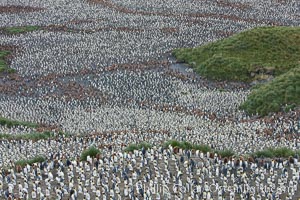
King penguin colony, over 100,000 nesting pairs, viewed from above. The brown patches are groups of 'oakum boys', juveniles in distinctive brown plumage. Salisbury Plain, Bay of Isles, South Georgia Island.
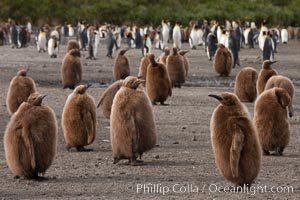
Oakum boys, juvenile king penguins at Salisbury Plain, South Georgia Island. Named 'oakum boys' by sailors for the resemblance of their brown fluffy plumage to the color of oakum used to caulk timbers on sailing ships, these year-old penguins will soon shed their fluffy brown plumage and adopt the colors of an adult.
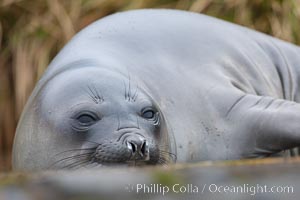
Southern elephant seal, juvenile. The southern elephant seal is the largest pinniped, and the largest member of order Carnivora, ever to have existed. It gets its name from the large proboscis (nose) it has when it has grown to adulthood.
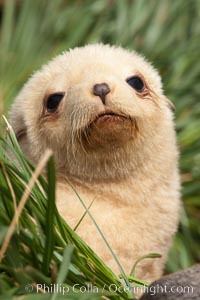
Leucistic juvenile antarctic fur seal, young pup, juvenile, blond. A leucistic animal is one that has pigmentation levels far below normal and is thus much more lightly colored.
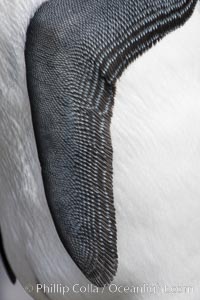
King penguin, wing detail. The king penguin uses its wings as flipper underwater, enabling it to swim fast.
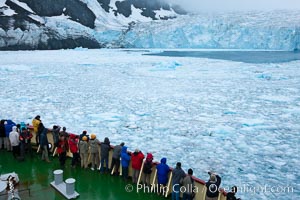
Drygalski Fjord, passengers on icebreaker M/V Polar Star. The water is packed with brash ice which has broken away from Risting Glacier at the end of the narrow fjord.
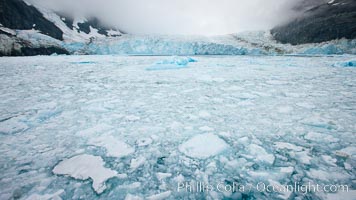
Drygalski Fjord, packed with brash ice which has broken away from Risting Glacier at the end of the narrow fjord.
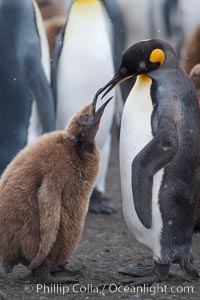
Juvenile 'oakum boy' penguin begs for food, which the adult will regurgitate from its stomach after foraging at sea. This scene plays out thousands of times each hour amid the vast king penguin colony at Salisbury Plain, where over 100,000 pairs of king penguins nest and rear their chicks.
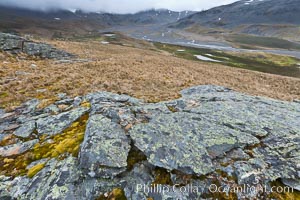
Grassy windy highlands and rocks, overlooking alluvial floodplain formed by glacier runoff near Stromness Bay.
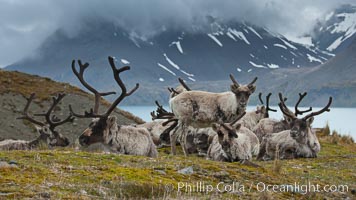
Reindeer on South Georgia Island. Reindeer (known as caribou when wild) were introduced to South Georgia Island by Norway in the early 20th Century. There are now two distinct herds which are permanently separated by glaciers.
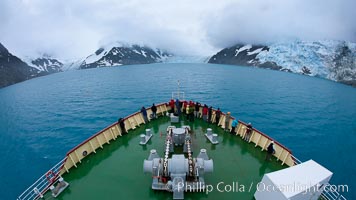
M/V Polar Star approaches Jenkins Glacier (left), Risting Glacier (center) and a third glacier (right) at the end of Drygalski Fjord.
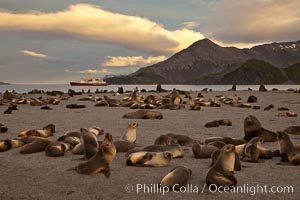
Antarctic fur seal colony, on a sand beach alongside Right Whale Bay, with the mountains of South Georgia Island in the background, sunset.
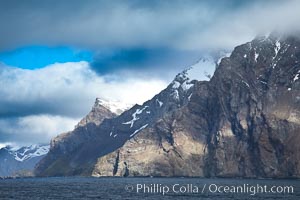
South Georgia Island coastline, showing the island's characteristic rugged topography. 56% of the island is covered by 161 glaciers, which have created numerous large bays and inlets that provide excellent habitat for marine animals and seabirds. Mountains meet the sea in steep-sided seacliffs covered with sparse vegetation. The highest point on South Georgia Island is Mt. Paget at 2,915m.
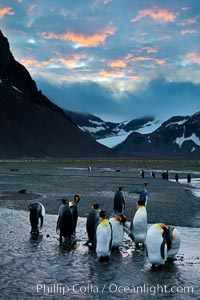
King penguin colony, Right Whale Bay, South Georgia Island. Over 100,000 pairs of king penguins nest on South Georgia Island each summer.
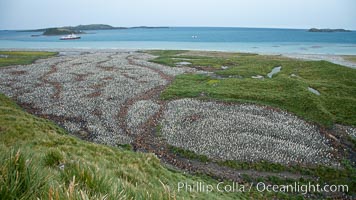
King penguin colony and the Bay of Isles on the northern coast of South Georgia Island. Over 100,000 nesting pairs of king penguins reside here. Dark patches in the colony are groups of juveniles with fluffy brown plumage. The icebreaker M/V Polar Star lies at anchor.
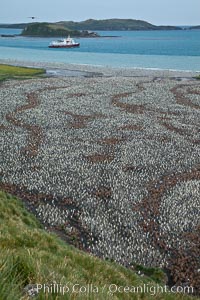
King penguin colony and the Bay of Isles on the northern coast of South Georgia Island. Over 100,000 nesting pairs of king penguins reside here. Dark patches in the colony are groups of juveniles with fluffy brown plumage. The icebreaker M/V Polar Star lies at anchor.
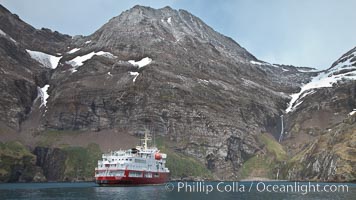
Hercules Bay, with icebreaker M/V Polar Star at anchor, below the steep mountains of South Georgia Island.
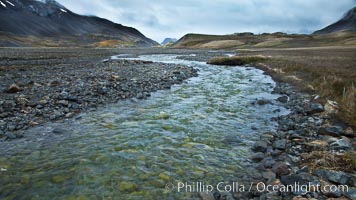
Glacial melt waters, runoff, flows across an alluvial flood plain between mountains, on its way to Stromness Bay.
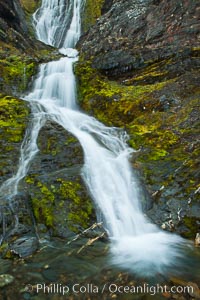
Shackleton Falls, named for explorer Sir Ernest Shackleton, formed from glacial meltwaters, near Stromness Bay.
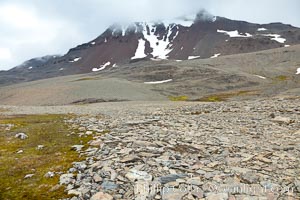
Shale covered rocky slope, near the pass over South Georgia Island between Fortuna Bay and Stromness Bay.
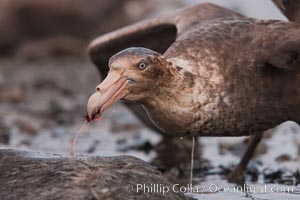
Northern giant petrel scavenging a fur seal carcass. Giant petrels will often feed on carrion, defending it in a territorial manner from other petrels and carrion feeders.
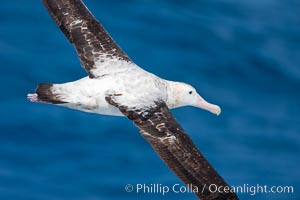
Wandering albatross in flight, over the open sea. The wandering albatross has the largest wingspan of any living bird, with the wingspan between, up to 12' from wingtip to wingtip. It can soar on the open ocean for hours at a time, riding the updrafts from individual swells, with a glide ratio of 22 units of distance for every unit of drop. The wandering albatross can live up to 23 years. They hunt at night on the open ocean for cephalopods, small fish, and crustaceans. The survival of the species is at risk due to mortality from long-line fishing gear.
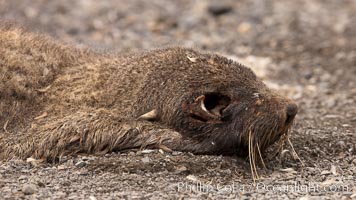
Antarctic fur seal carcass, lying on pebble beach. Dead fur seals are quickly scavenged by giant petrels, leaving the pelt and skeleton of the dead fur seal.
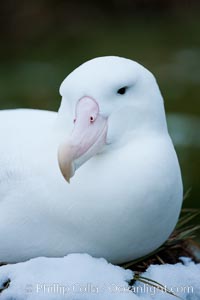
Wandering albatross, on nest and the Prion Island colony. The wandering albatross has the largest wingspan of any living bird, with the wingspan between, up to 12' from wingtip to wingtip. It can soar on the open ocean for hours at a time, riding the updrafts from individual swells, with a glide ratio of 22 units of distance for every unit of drop. The wandering albatross can live up to 23 years. They hunt at night on the open ocean for cephalopods, small fish, and crustaceans. The survival of the species is at risk due to mortality from long-line fishing gear.
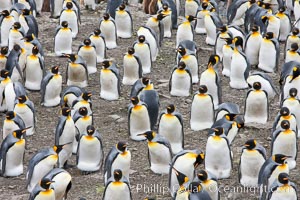
King penguin colony. Over 100,000 pairs of king penguins nest at Salisbury Plain, laying eggs in December and February, then alternating roles between foraging for food and caring for the egg or chick.
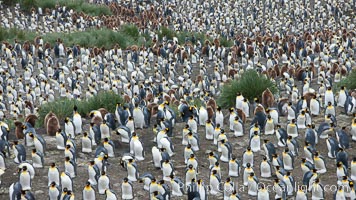
King penguin colony. Over 100,000 pairs of king penguins nest at Salisbury Plain, laying eggs in December and February, then alternating roles between foraging for food and caring for the egg or chick.
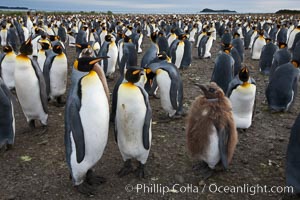
King penguins at Salisbury Plain. Silver and black penguins are adults, while brown penguins are 'oakum boys', juveniles named for their distinctive fluffy plumage that will soon molt and taken on adult coloration.
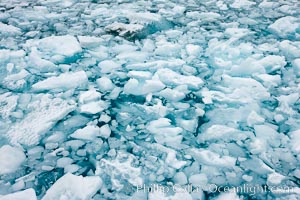
Drygalski Fjord, packed with brash ice which has broken away from the glacier at the end of the narrow fjord.
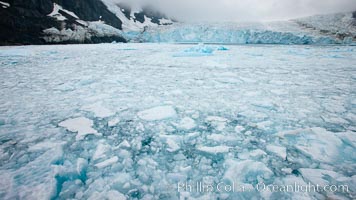
Drygalski Fjord, packed with brash ice which has broken away from the glacier at the end of the narrow fjord.
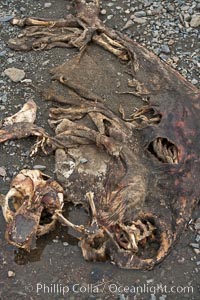
Antarctic fur seal carcass, lying on pebble beach. Dead fur seals are quickly scavenged by giant petrels, leaving the pelt and skeleton of the dead fur seal.
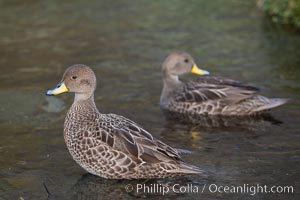
The South Georgia Pintail duck, also known as the South Georgian Teal, is endemic to South Georgia Island and is a vagrant to the South Sandwich Islands. The South Georgia Pintail feeds on a variety of marine and freshwater vegetation, including algae, as well as upon invertebrates.
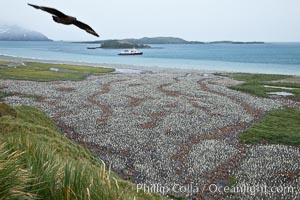
King penguin colony and the Bay of Isles on the northern coast of South Georgia Island. Over 100,000 nesting pairs of king penguins reside here. Dark patches in the colony are groups of juveniles with fluffy brown plumage. The icebreaker M/V Polar Star lies at anchor.
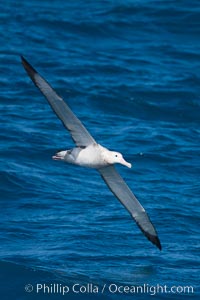
Wandering albatross in flight, over the open sea. The wandering albatross has the largest wingspan of any living bird, with the wingspan between, up to 12' from wingtip to wingtip. It can soar on the open ocean for hours at a time, riding the updrafts from individual swells, with a glide ratio of 22 units of distance for every unit of drop. The wandering albatross can live up to 23 years. They hunt at night on the open ocean for cephalopods, small fish, and crustaceans. The survival of the species is at risk due to mortality from long-line fishing gear.
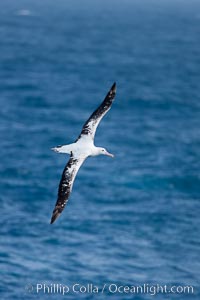
Wandering albatross in flight, over the open sea. The wandering albatross has the largest wingspan of any living bird, with the wingspan between, up to 12' from wingtip to wingtip. It can soar on the open ocean for hours at a time, riding the updrafts from individual swells, with a glide ratio of 22 units of distance for every unit of drop. The wandering albatross can live up to 23 years. They hunt at night on the open ocean for cephalopods, small fish, and crustaceans. The survival of the species is at risk due to mortality from long-line fishing gear.
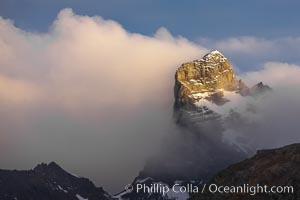
South Georgia Island, spire and sunset clouds, showing the island's characteristic rugged topography. 56% of the island is covered by 161 glaciers, which have created numerous large bays and inlets that provide excellent habitat for marine animals and seabirds. Mountains meet the sea in steep-sided seacliffs covered with sparse vegetation. The highest point on South Georgia Island is Mt. Paget at 2,915m.
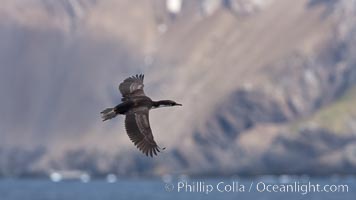
South Georgia shag, or Imperial shag, a type of cormorant, in flight alongside South Georgia Island.
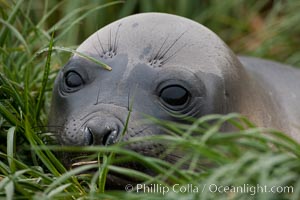
Southern elephant seal, juvenile. The southern elephant seal is the largest pinniped, and the largest member of order Carnivora, ever to have existed. It gets its name from the large proboscis (nose) it has when it has grown to adulthood.
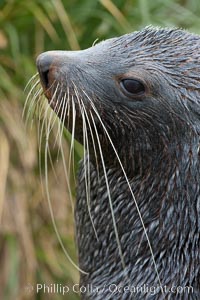
Antarctic fur seal, adult male (bull), showing distinctive pointed snout and long whiskers that are typical of many fur seal species.
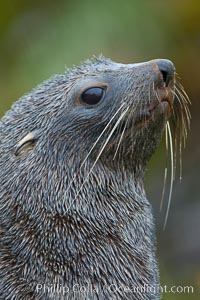
Antarctic fur seal, adult male (bull), showing distinctive pointed snout and long whiskers that are typical of many fur seal species.
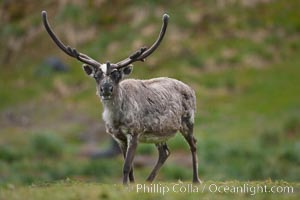
Reindeer on South Georgia Island. Reindeer (known as caribou when wild) were introduced to South Georgia Island by Norway in the early 20th Century. There are now two distinct herds which are permanently separated by glaciers.
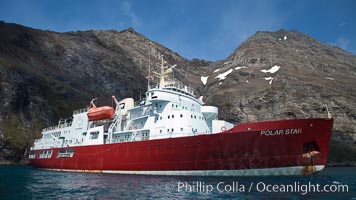
Hercules Bay, with icebreaker M/V Polar Star at anchor, below the steep mountains of South Georgia Island.
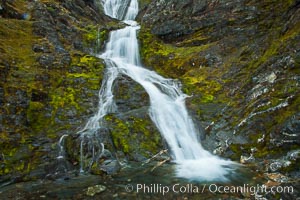
Shackleton Falls, named for explorer Sir Ernest Shackleton, formed from glacial meltwaters, near Stromness Bay.
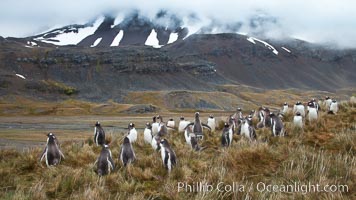
Gentoo penguins, permanent nesting colony in grassy hills about a mile inland from the ocean, near Stromness Bay, South Georgia Island.
